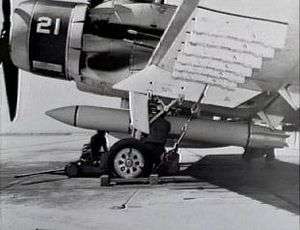Hopi (missile)
The Hopi was an air-to-surface missile developed by the United States Navy's Naval Ordnance Test Station. Intended to provide a medium-range nuclear capability for carrier aircraft, the missile reached the flight test stage during 1958, but the project was cancelled following testing and no production was undertaken.
| Hopi | |
|---|---|
 Hopi mounted on an AD-5N Skyraider | |
| Type | Air-to-surface missile |
| Place of origin | United States |
| Service history | |
| Used by | United States Navy |
| Production history | |
| Manufacturer | Naval Ordnance Test Station |
| Specifications | |
| Warhead | W50 thermonuclear |
| Blast yield | 60 to 400 kilotonnes of TNT (250 to 1,670 TJ) |
Design and development
Developed by the Naval Ordnance Test Station (NOTS) at China Lake, California during the mid-to-late 1950s,[1] the Hopi missile was an improved development of the earlier BOAR (Bombardment Aircraft Rocket). BOAR had been developed at China Lake as an unguided, nuclear-armed rocket for use by carrier-based aircraft, seeing limited service in the fleet between 1957 and 1963.[2]
In its essentials simply an enlarged version of BOAR,[2] which it was intended to replace in service, Hopi was designed as a medium-range weapon capable of being carried by a wide variety of carrier-based fighter and attack aircraft.[3] The rocket-powered missile was capable of being fitted with a W50 nuclear warhead capable of producing a yield between 60 and 400 kilotons; however, no details of the planned guidance system for the missile, or if there even was intended to be guidance at all, have survived.[1]
Operational history
Following its development, the Hopi missile was flight-tested on the China Lake weapons range during 1958.[1] The missile was test-fired from a variety of aircraft, including the North American FJ-4 Fury, Douglas AD Skyraider,[1] Douglas A3D Skywarrior and Douglas A4D Skyhawk.[4] However, no details of the tests are known to have survived,[1] and the Hopi project was cancelled shortly thereafter.[2]
References
Notes
- Parsch 2003
- Babcock 2008, p.323.
- Jacobs and Whitney 1962, p.80.
- 1958 Photo Gallery, Photographic History of NAF & VX-5 at NOTS China Lake. Accessed 2010-12-29.
Bibliography
- Babcock, Elizabeth (2008). Magnificent Mavericks: transition of the Naval Ordnance Test Station from rocket station to research, development, test and evaluation center, 1948-58. History of the Navy at China Lake, California. 3. Washington, DC: Government Printing Office. ISBN 978-0945274568.
- Jacons, Horace; Eunice Engelke Whitney (1962). Missile and Space Projects Guide: 1962. New York: Plenum Press. ASIN B0007E2BBK.
- Parsch, Andreas (2003). "NOTS Hopi". Directory of U.S. Military Rockets and Missiles. designation-systems.net. Retrieved 2010-12-29.